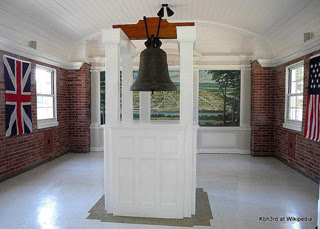In our lifetime the 4th of July has meant cookouts, fireworks and travel but throughout Illinois’ history the July 4th date has had other significant historical importance. Here are a few July 4th dates beyond 1776 that impacted Illinois:
On July 4, 1778, George Rogers Clark, the highest-ranking Patriot military officer on the northwestern frontier during the Revolutionary War, reached Kaskaskia, seizing it from the British and bringing the colonies’ battle for independence to the western edge of British territory in North America. Villagers celebrated by ringing a bell that is known today as “the Liberty Bell of the West.” The bell, cast in La Rochelle, France in 1741 and sent to the French settlers in Kaskaskia by King Louis XV, is older than Philadelphia’s Liberty Bell.
On July 4, 1819, the 21st star was officially added to the United States flag representing Illinois’ admittance as the 21st state into the union.
The star representing Illinois was the first added to the flag under the Flag Act of 1818 defining how stars are added to the United States flag. The Flag Act provided for 13 stripes and one star for each state, to be added to the U.S. flag on the 4th of July following the admission of each new state and remains in effect to this day. Illinois was recognized as a state on December 3, 1818 which is why its star was add on the following July 4th.
According to Dr. Samuel Wheeler, former state historian of Illinois and director of research and collections at the Abraham Lincoln Presidential Library and Museum in Springfield, the first Fourth of July celebrations after Illinois was granted statehood were geared toward Reverence for the Revolution, which had taken place less than 50 years earlier. Americans at the time held the leaders and veterans of the Revolution in the highest esteem and honored them at July 4th celebrations.
0n July 4, 1836, ground was broken on the Illinois-and-Michigan Canal. This canal provided the first complete water route from the east coast to the Gulf of Mexico by connecting Lake Michigan to the Mississippi River by way of the Illinois River. French explorers Joliet and Marquette recognized the value of this water route for navigation in the 1600s. It was used heavily by Native Americans and traders from this time until 1823 when Illinois created a Canal Commission to oversee design and construction of the I & M Canal. The canal was not completed until 1848, at a cost of $6.5 million.
On July 4, 1837, the cornerstone of the Old State Capitol was laid in Springfield, paving the way for the relocation of state government from Vandalia. After many delays the building finally was completed in 1853 at a total cost of $260,000, double the original estimate.
Since 1818, the Capital of Illinois has been located in three different locations: Kaskaskia, Vandalia and Springfield; with six Capitol buildings, of which five were State owned, and three still standing; one in Vandalia and two in Springfield.
On July 4, 1839, all state records were to be moved to Springfield from Vandalia. However, state government did not actually operate in Springfield until December of that year.
On July 4, 1863, during the Civil War, Union Army soldiers; including thousands from Illinois; under the command of General Ulysses S. Grant of Galena, celebrated the surrender of Vicksburg, Mississippi, which ended a months-long campaign and siege against the last Confederate-held city on the Mississippi River. President Abraham Lincoln celebrated the good news of the Union’s newly-gained control of the vital waterway by stating that “the Father of Waters again goes unvexed to the sea.”
On July 4, 1870, Independence Day was first designated as a federal holiday, and it became a paid holiday for federal employees in 1941.
Read more about our state capitols:Moving to Springfield
Where Lincoln’s Words Still Echo
